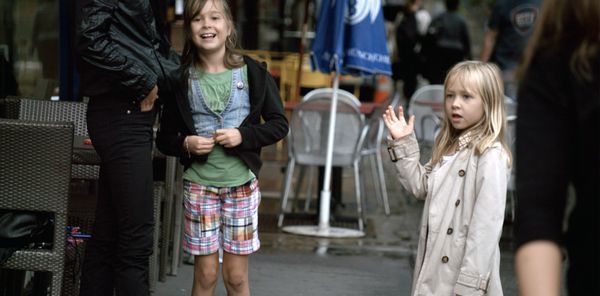 |
| Jamie Nares on integrating Thurston Moore’s music into the soundtrack of the spectacular Street: “I worked very closely with my sound designer, Bill Seery.” Photo: Nares Studio |
Equipped with a high-definition camera and telephoto lens, Jamie Nares drove through the streets of New York in 2011 to film in six-second bursts the goings on. The footage then was slowed down and edited into a stream of floating street scenes, a moving snapshot of the hustle and bustle in the different neighbourhoods of the city. With our pandemic conditioned eyes, viewers today may notice no mask wearing.
 |
| Anne-Katrin Titze showing Jamie Nares a scene from Gene Kelly and Stanley Donen’s On The Town |
There are pay phones and a lot of taxis. People still carry plastic bags with logos from shops and fewer than now have their glance fixed on the phone in hand. Food vendors and tourists, fire hydrants and the elegant New York City garbage cans that haven’t changed since the first half of the 20th century. Thurston Moore’s original acoustic 12-string guitar music and from his album Solo Acoustic, Vol. 5 (12 String For Jack Rose), smoothly edited to the images by Nares and sound designer Bill Neery, pushes on and simultaneously holds back.
“Stay a while, you are so fair,” is part of the bet the devil makes in Goethe’s Faust. We see the street fashions of then and the conveyor belt motion allows for an unhurried inspection of faces and body language. Which, because of the reduced speed in motion, can lead to fantastic misinterpretations of intent, and is the point of Street. It sharpens our perception and at the same time humbles us, because we can feel in our bones that nothing ever really is as it seems.
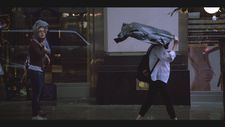 |
| Jamie Nares on another Gene Kelly reference: “Definitely singing in the rain.” Photo: Nares Studio |
Seeing Jamie Nares’s spectacular Street started with an introduction by music producer and 99 Records founder Ed Bahlman to the filmmaker/artist at Eva Prinz and Thurston Moore’s Ecstatic Peace Library Rock ’n’ Roll Round Table series at The Algonquin last month during the exhibition Linger On: Unseen Portraits of The Velvet Underground by James Hamilton, curated by Eva and Thurston. Other participants included Richard Hell (featured in Celine Danhier’s Blank City with his band Richard Hell and the Voidoids and as the star of Susan Seidelman’s Smithereens), Katharine Faw, Colson Whitehead, Kyoo Lee, and Sampson Starkweather.
Linger On: The Velvet Underground - Legends, Truth, Interviews by Ignacio Julià is scheduled for publication by Ecstatic Peace Library on October 28. The comprehensive and impressive book (edited by Eva Prinz and designed by Christian Corliss) will include photographs by Gerard Malanga, Billy Name, Bob Gruen, Lynn Goldsmith, Andy Warhol, Bobby Gillespie, and James Hamilton. There are extensive and personal interviews with Todd Haynes (director of The Velvet Underground), Lou Reed (the Lou Reed: Caught Between The Twisted Stars exhibition is currently on view at The New York Public Library for the Performing Arts at Lincoln Center), John Cale, Sterling Morrison, Maureen Tucker, Nico, Lenny Kaye, Jackson Browne, Doug Yule, and Gerard Malanga with contributions from Deb Googe, Bobby Gillespie, and Thurston Moore. Especially impressive are the contemporaneous detailed accounts by Ignacio Julià in the introductions before he enters into each interview.
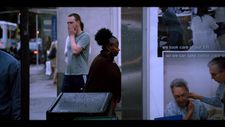 |
| Jamie Nares: “Well the whole thing is kind of like a fairy tale because of the way I shot it, which is always with the camera in motion.” Photo: Nares Studio |
Jamie Nares (whose films as James Nares were also featured in Blank City) is currently at Frieze in London, represented by Kasmin Gallery. Street, and a number of Nares’s early films will be shown during the exhibition (details below the conversation).
In 2020, during the height of the Covid pandemic in New York City, The Metropolitan Museum of Art projected Street on the museum’s south-facing wall in Central Park from November 27 through November 29.
From Upstate New York, Jamie Nares joined me on Zoom for an in-depth conversation on Street.
Anne-Katrin Titze: I watched Street earlier today, eleven years after it was made and it’s spectacular.
Jamie Nares: Thank you!
AKT: When was the last time you watched it?
JN: I don’t remember, but within the last year. I saw it quite a lot; I edited it.
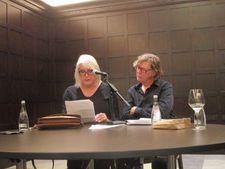 |
| Jamie Nares with Thurston Moore at the Ecstatic Peace Library Rock ’n’ Roll Round Table at The Algonquin Photo: Anne-Katrin Titze |
AKT: It’s fascinating to see what changed and what didn’t change in the city. The film is New York and how much New York is connected to history. Do you remember the first film you saw about New York?
JN: Probably [Sam Fuller’s] Pick Up on South Street or one of those nice black and white films from years ago from the Fifties. There were many films on TV when I was growing up of New York.
AKT: Was that part of the attraction, those images, for you in the beginning to come to New York?
JN: I think the whole American thing. It wasn’t specifically New York. I was attracted specifically by my knowledge of what was happening in New York by reading all the American art magazines. Feverishly, as soon as they came out I poured over them. I was aware of the importance of New York to the art community and I wanted to be part of it because no one in England knew who those people were.
AKT: We met Monday [September 12] at The Algonquin, which has such a tremendous history. Wednesday I was at The Explorers Club which was founded in 1904. History is never far, you can hardly catch a corner that doesn’t hum with history on the surface. Was that part of the inspiration for Street?
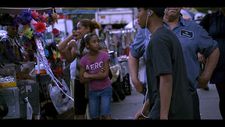 |
| Street in Harlem Photo: Nares Studio |
JN: I think so. On the whole, the history of New York is only a few hundred years old, compared to a European city which we would know better, maybe where the history is so deep. When I came to New York, everything in America seemed like it was new. It still is. When I was making the film I was aware that I was creating history in a way.
It was those films, they called them Phantom Films, actuality films that were made in this country, around the turn of the century many of them, like after the great fire of San Francisco, where they just wheeled a camera through the streets and filmed it just the way I did. They were usually straight forward; I was always perpendicular to the streets. They would film San Francisco and show it in Chicago, or they’d film Chicago and show it in New York, because people didn’t travel as much or hardly at all. So it was as if you’re visiting another city. But I was interested in creating a historical document.
AKT: Street clearly is one.
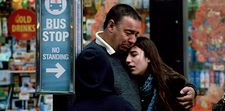 |
| Comforting couple in Street Photo: Nares Studio |
JN: When I proposed the film a couple of years earlier than I actually shot it, I think in 2009, I proposed it to the Guggenheim. Some grant, I can’t remember what it was. And I described exactly the film that I ended up making, which was a record of a time and place. I wish I had done it in the Seventies when I first arrived.
AKT: As well, both! It’s as fascinating to see 2011 as it would have been to see the Seventies.
JN: I know. Thanksgiving 2020 in the height of COVID, they showed it on the south wall of The Metropolitan Museum in a giant projection.
AKT: I know! I think it was the first time ever that anyone’s work was projected on the outside of The Met, right?
JN: I guess, yeah. It was a great honour and it looked spectacular. It’s quite a moving film, but in the time of COVID there was this additional flavour to the mix.
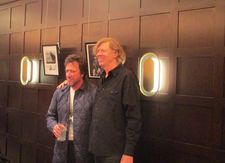 |
| Richard Hell with Thurston Moore in the Oak Room of The Algonquin Photo: Anne-Katrin Titze |
AKT: Because then the question was: Will the city come back? Will we ever have that many people on the streets again? Even watching it now, you think, nobody is wearing a mask. Timing and time are so important, also because of what you did - the high definition camera, the lens, and the fact that you slowed it down which in a way gives us the time that we never have when we walk in the street. Time is the essence here.
JN: It is. And you see these fragments of time expanded into a disproportionately long clip. And it’s a little bit like a still photograph where you see before it happens and after it happened. And you get to experience the quality of capturing time.
AKT: Which we otherwise never get. It’s something very much out of fairy tales. It’s the once upon a time effect. I have courses right now at Hunter College on fairy tales and storytelling.
JN: It’s funny because I never thought of myself as a narrative filmmaker. I tried once when I made Rome ’78, but even in that film it’s not the narrative that holds it together. It’s something else. In Street I realized that I ended up making a collection of mini-narratives; each of which has a beginning, a middle, and an end. Within that short time framing is a wealth of events that take place.
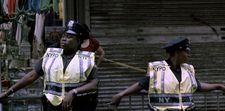 |
| NYPD at the ready in Street Photo: Nares Studio |
AKT: You even have a Little Red Riding Hoodie at one point.
JN: Yes!
AKT: On a phone booth there is a poster for the TV show Once Upon a Time on display. I of course picked up on those.
JN: Well the whole thing is kind of like a fairy tale because of the way I shot it, which is always with the camera in motion. I had to be traveling always at 30 to 40 miles an hour in order to be able to shoot, because I wanted to have this feeling of floating through the city. So it is like an angel floating through the city and I like that.
AKT: Or a magic carpet?
JN: A magic carpet, yeah, Aladdin.
AKT: You are giving us the feeling of floating definitely. It’s interesting that most of the people who notice you are children.
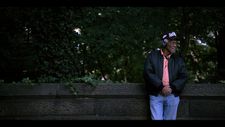 |
| At the park wall in Street Photo: Nares Studio |
JN: Yes, children. And young Black men who are much more street aware than other people because they have to be. But you’re right, kids have their eyes open all the time. We close our eyes down as we get older.
AKT: It’s The Emperor’s New Clothes; the child knows that the ruler isn’t wearing any clothes and says so. Thurston’s music has clear breaks when it shifts into another mood. How did you work with him on that?
JN: I worked very closely with my sound designer, Bill Seery. I had originally wanted a soundtrack where I recorded the sounds of the street and slow them down to reveal something about sound that we haven’t heard before, but it didn’t work. It sounds very digitized when you slow sound way down. It made everything drag like in the mud. So I tried driving through the streets with a shotgun microphone pointing out the window, recording snippets of conversation, but even that didn’t have what I wanted.
Then we were editing and listening to music at the same time and realized, oh my god, this is wonderful with music, it needs music. Then it was just deciding what music. I wanted someone who knew New York and the scene that I was part of and Thurston was just the obvious choice to me. He was very generous with his time.
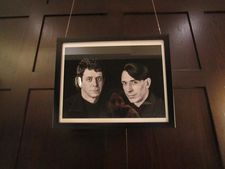 |
| Lou Reed and John Cale, Songs for Drella shoot, 1989 by James Hamilton (Oak Room of The Algonquin) |
He was just going off on tour actually, and he recorded an hour of solo 12 string guitar. He gave me that and also access to a small 12-string album [Solo Acoustic, Vol. 5 (12 String For Jack Rose)] that he had put out. We mixed the two together and created the soundtrack out of it. I have to give credit to Bill Seery because he did a beautiful job. I wanted the soundtrack to be one person, kind of in opposition to the cast of thousands in the film itself.
AKT: It is a good juxtaposition.
JN: One person meandering through their mind in the same way we were meandering through the city.
AKT: One of the first big feature films that had someone driving through the actual city past the sights, was Stanley Donen and Gene Kelly's On the Town in 1949, music by Leonard Bernstein. You remember that?
JN: No, I’ve never seen that film.
AKT: Ed has queued up the scene for you! Let’s play it.
JN: Oh, I remember. I was more watching films like On the Waterfront.
AKT: I thought about it with the fruit vendors, the magazine kiosks, the fire hydrants. I noticed in your film how many pay phones still existed in 2011 and plastic bags which thankfully no longer are everywhere. It’s very interesting how in these eleven years the streets changed; that is the film’s archival quality.
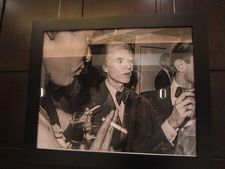 |
| Andy Warhol at The Carlyle, 1971 by James Hamilton (Oak Room of The Algonquin) |
JN: When I proposed the film I said I wanted to make a film to be seen 100 years from now. Maybe that’s why I didn’t get the funding. I meant it. I almost just wanted it out in a time capsule and wave goodbye to it. But it does locate us at a very specific moment in time and yet there’s this timelessness about the expressions on people’s faces and the nuances of what is going on. I didn’t want any dramatic moments. I didn’t want to go searching for people being mugged or anything like that. I wanted the drama of exchanges of eye contact.
AKT: Did you capture any of that by mistake? In all the hours were there any muggings that you inadvertently recorded?
JN: There weren’t muggings but there were other things that happened. One of the most astonishing things that happened is completely unastonishing in the film itself but I had to include it. When that little kid hits the baseball. We passed the baseball field and we said let’s go around again, maybe we can get a shot, which we did.
Of course we were traveling very fast, and he just happened to hit the ball, it connected right there. The whole film distorts reality in a very interesting way. It reveals things you don’t see and creates things that didn’t happen. Like, you see this guy staring at his shoelaces. He’s looking like he’s so depressed and sad. But when you see it in real speed he’s just glancing to see if he tied his shoelaces.
AKT: Several times people seem to be stretching out their hands as if they wanted to touch the person in front of them. Obviously they are just walking, swinging their arms. Very very interesting. There is a great moment in front of Temple Emanu-El for a funeral and a grandfather is playing with a little boy.
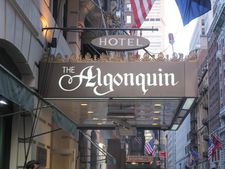 |
| Ecstatic Peace Library was in residence at The Algonquin Photo: Anne-Katrin Titze |
JN: I love that.
AKT: That’s a beautiful moment.
JN: The whole shot is exquisite. People enter and exit as if I were giving them cues. Then the old man comes forward with his hand out, it’s like Moses, and he looks up at the sky. It’s really a beautiful moment.
AKT: And what people do in the rain in New York! That great sculptural garbage bag covering and the different umbrellas and the little girl in the summer dress who doesn’t care and is singing in the rain. There’s Gene Kelly again.
JN: Definitely singing in the rain.
AKT: The pigeon is absolutely terrific.
JN: I figured that pigeons are a large part of New York City and that I should film a pigeon if I got the opportunity. I caught it beautifully, I think. The result is that this pigeon looks like a bird of prey and I figured if I can make a New York pigeon look heroic, I could do anything.
AKT: It is also quite eye-opening to look at the clothes people were wearing in 2011.
JN: There were some things I didn’t get, that I would liked to have got, maybe like a fashion shoot on the street, which you see all the time. That’s a very New York thing, models being photographed. There are plenty of other people being photographed. I loved the woman outside the Guggenheim, leaning way back with her camera. And you don’t know what she’s up to. Then you see that she’s photographing three of her friends.
 |
| Colson Whitehead, Kyoo Lee, Jamie Nares - Ecstatic Peace Library at The Algonquin |
AKT: She has olive-green shorts and an olive-green bag and olive-green tights. I remember her!
Read what Jamie Nares, in conversation with Ed Bahlman, had to say on New York in the Seventies and Eighties, Rome ’78, Pierpaolo Piccioli’s Valentino couture dress for Jamie, a party for Andy Warhol’s Athletes series, Bob Dylan, David Bowie, Marc Bolan, Joseph Chaikin and Merce Cunningham in Westbeth, The Metropolitan Museum of Art Costume Institute, exhibiting at the upcoming Frieze in London, and being in and out of the Contortions.
Jamie Nares at Frieze Kasmin Gallery: James Nares No. 9 Cork Street runs through October 22. Film screenings during Frieze: Tuesday, October 11 at 4:00pm - Street (2011); Suicide? No! Murder (1977); Waiting For The Wind (1982); Game (1976); Drip (2007); Primary Function (2007); Pendulum (1976) - Saturday, October 22 at 11:00am and 1:00pm - Pendulum and Street. Jamie will be in conversation with Hans Ulrich Obrist.





















